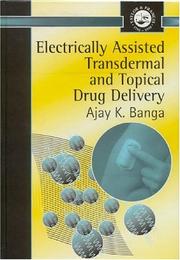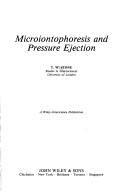| Listing 1 - 7 of 7 |
Sort by
|
Book
Year: 1992 Publisher: Bruxelles: UCL,
Abstract | Keywords | Export | Availability | Bookmark
 Loading...
Loading...Choose an application
- Reference Manager
- EndNote
- RefWorks (Direct export to RefWorks)
L’iontophorèse permet de promouvoir l’administration transcutanée aisée des molécules chargées comparativement à la diffusion passive. Au cours de ce travail, nous avons étudié différents facteurs électrochimiques qui peuvent influencer le transport iontophorétique du fentanyl, du sufentanyl ou du métopropol. Nous avons jugé également utile d’étudier le mécanisme du transport iontophorétique en déterminant les voies probables qu’emprunte une molécule de l’iontophorèse et en vérifiant si la perméabilité de la peau ou si le courant continu des lésions cutanées plus qu’un courant pulsé.
L’application d’un courant électrique augmente nettement le passage transcutané du fentanyl ou du sufentanyl. La vitesse de ce passage dépend de l’intensité du courant appliqué. Elle est plus rapide à pH3,5 qu’à pH7. L’application d’un courant continu de densité 0,33 mA/cm2 donne des meilleurs résultats qu’un courant pulsé de même intensité. Plus la durée d’application du courant augmente plus la quantité de fentanyl dans le récepteur augmente. En ce qui concerne le caractère lipophile d’un médicament, la simple diffusion est plus marquée pour des molécules lipophiles. Cependant, les molécules hydrophiles sont plus sensibles à l’iontophorèse.
Les études de la migration iontophorétique du métoprolol à travers une membrane de cellophane ont montré que la diffusion passive des ions était relativement importante. Cette migration est plus efficace dans un milieu de faible force ionique de pH3,5 ou de pH7.
Les essais in vitro réalisé à travers une peau de rat nu indiquent que le courant est plus efficace que le courant pulsé, tandis qu’un courant pulsé de rapport on/off 1/1 est plus efficace que celui de rapport on/off 1/3.
Nos résultats et ceux de la littérature semblent indiquer que pour certaines molécules, el courant continu augmente plus leur passage transdermique que le courant pulsé alors que pour d’autres molécules, principalement des peptides, des résultats inverses ont été observés. Pour tenter de confirmer la différence de comportement observée entre les petites molécules et les peptides, l’iontophorèse in vitro et in vivo d’autres molécules peptidiques sera envisagée.
Nous avons également montré que l’insuline administrée par iontophorèse emprunte préférentiellement la voie de passage transfolliculaire. Des études par autoradiographie seront réalisées ultérieurement pour localiser les voies de passage du fentanyl et du sufentanyl et pour évaluer l’effet réservoir de la peau.
L’application d’un courant continu ou pulsé pendant une heure n’induit pas de modification de le peau à l’eau. Par contre la perméabilité de la peau est fortement augmentée lorsque le courant électrique est appliqué pendant 6 heures. Des analyses permettant de comprendre les modifications de la structure du stratum corneum (FTIR), de la fonction de barrière de la peau (mesure de la capacitance et de l’évaporation d’eau) et du flux sanguin cutané (vélocimétrie Laser Doppler) seront réalisées.
Iontophoresis --- Injections, Subcutaneous --- Drug Administration Routes

ISBN: 0748406875 Year: 1998 Publisher: London : Taylor and Francis,
Abstract | Keywords | Export | Availability | Bookmark
 Loading...
Loading...Choose an application
- Reference Manager
- EndNote
- RefWorks (Direct export to RefWorks)
Electro-osmosis. --- Electroporation. --- Iontophoresis. --- Transdermal medication.
Book
Year: 1930 Publisher: Paris : Gauthier-Villars et cie, éditeurs,
Abstract | Keywords | Export | Availability | Bookmark
 Loading...
Loading...Choose an application
- Reference Manager
- EndNote
- RefWorks (Direct export to RefWorks)
Iontophoresis --- Iontophoresis. --- Therapeutics. --- Therapeutics --- Ionophorèse --- Ionophorèse. --- Thérapeutique. --- treating (health care function) --- Therapeutic use. --- Emploi en thérapeutique.

ISBN: 0471906077 9780471906070 0471906085 9780471906087 Year: 1985 Publisher: Chichester Wiley
Abstract | Keywords | Export | Availability | Bookmark
 Loading...
Loading...Choose an application
- Reference Manager
- EndNote
- RefWorks (Direct export to RefWorks)
Action potentials (Electrophysiology) --- Iontophoresis --- Microinjections --- Neurotransmitters --- Electrophysiology --- Mammals --- Brain --- Research --- Microiontophoresis
Book
ISBN: 0824728076 Year: 1993 Publisher: New York, NY : Marcel Dekker,
Abstract | Keywords | Export | Availability | Bookmark
 Loading...
Loading...Choose an application
- Reference Manager
- EndNote
- RefWorks (Direct export to RefWorks)
HYDROLYSE --- HYDROLYSIS --- PHARMACEUTICAL DOSAGE FORMS --- IMMUNOENZYME TECHNICS --- IMMUNOASSAY --- IMPLANTS --- IMPLANTATION THERAPY --- INFRARED SPECTROSCOPY --- INSTRUMENTATION AND EQUIPMENT : PHARMACY --- INTERFACIAL PHENOMENA : PHARMACY --- INTRANASAL DRUG DELIVERY --- GOUTTES NASALES --- SUSTAINED-RELEASE DRUG DELIVERY SYSTEMS --- IONTOPHORESIS --- IRRIGATION SOLUTIONS --- ISOMERISM AND ISOMERS --- FLUX LAMINAIRE --- LAMINAR AIRFLOW EQUIPMENT --- ENGINEERING CONTROL & ASEPTIC PROCESSING --- ASEPTIC PROCESSING : PHARMACY --- LENTILLES DE CONTACT --- LENS CARE PRODUCTS --- LIABILITY ASPECTS OF DRUGS AND DEVICES --- LIPIDS IN PHARMACEUTICAL DOSAGE FORMS --- PHARMACY --- PRODUITS D'ENTRETIEN
Book
Year: 2022 Publisher: Basel MDPI - Multidisciplinary Digital Publishing Institute
Abstract | Keywords | Export | Availability | Bookmark
 Loading...
Loading...Choose an application
- Reference Manager
- EndNote
- RefWorks (Direct export to RefWorks)
Disorders of the central and peripheral nerve systems have severe effects on gut function. Hence, people who have sustained spinal cord injury and multiple sclerosis, Parkinson’s disease, or spina bifida patients may suffer from severe bowel symptoms, including constipation, incontinence to stools, difficult bowel evacuation, or pain. For the present book, a number of international experts have described how disorders of the nerve system affect bowel function, how to assess and treat bowel symptoms, and how the bacterial composition of the bowel may be affected.
laxatives --- constipation --- adults --- prevalence --- utilisation --- gut microbiota --- spina bifida --- transanal irrigation --- urinary tract infection --- SCI --- MENTOR --- NBD --- fecal incontinence --- Parkinson’s disease --- autonomic --- gastrointestinal --- alpha-synuclein --- parasympathetic --- neurogenic bowel dysfunction --- low anterior resection syndrome --- faecal incontinence --- chronic constipation --- bowel dysfunction --- quality of life --- spinal cord injury --- multiple sclerosis --- pharmacological --- systematic review --- neurogenic bowel --- treatment assessment --- bowel function --- exoskeletal walking --- difficulty with evacuation --- neostigmine --- glycopyrrolate --- iontophoresis --- autonomic dysfunction --- motility --- investigations --- manometry --- breath test --- imaging --- diabetes mellitus --- postprandial hypotension --- food ingestion --- ambulatory blood pressure measurement --- cohort study --- pediatric --- children --- adolescent --- anorectal malformation --- cerebral palsy --- acute rehabilitation --- opioids --- SCI bowel management
Book
Year: 2022 Publisher: Basel MDPI - Multidisciplinary Digital Publishing Institute
Abstract | Keywords | Export | Availability | Bookmark
 Loading...
Loading...Choose an application
- Reference Manager
- EndNote
- RefWorks (Direct export to RefWorks)
Disorders of the central and peripheral nerve systems have severe effects on gut function. Hence, people who have sustained spinal cord injury and multiple sclerosis, Parkinson’s disease, or spina bifida patients may suffer from severe bowel symptoms, including constipation, incontinence to stools, difficult bowel evacuation, or pain. For the present book, a number of international experts have described how disorders of the nerve system affect bowel function, how to assess and treat bowel symptoms, and how the bacterial composition of the bowel may be affected.
Medicine --- Neurology & clinical neurophysiology --- laxatives --- constipation --- adults --- prevalence --- utilisation --- gut microbiota --- spina bifida --- transanal irrigation --- urinary tract infection --- SCI --- MENTOR --- NBD --- fecal incontinence --- Parkinson’s disease --- autonomic --- gastrointestinal --- alpha-synuclein --- parasympathetic --- neurogenic bowel dysfunction --- low anterior resection syndrome --- faecal incontinence --- chronic constipation --- bowel dysfunction --- quality of life --- spinal cord injury --- multiple sclerosis --- pharmacological --- systematic review --- neurogenic bowel --- treatment assessment --- bowel function --- exoskeletal walking --- difficulty with evacuation --- neostigmine --- glycopyrrolate --- iontophoresis --- autonomic dysfunction --- motility --- investigations --- manometry --- breath test --- imaging --- diabetes mellitus --- postprandial hypotension --- food ingestion --- ambulatory blood pressure measurement --- cohort study --- pediatric --- children --- adolescent --- anorectal malformation --- cerebral palsy --- acute rehabilitation --- opioids --- SCI bowel management
| Listing 1 - 7 of 7 |
Sort by
|

 Search
Search Feedback
Feedback About UniCat
About UniCat  Help
Help News
News